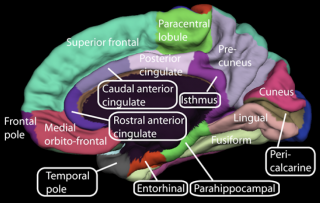
Environment
Disrupting Consciousness
Interfering with brain’s “connector hub” affected conscious experience.
Posted April 9, 2014
Scientists in France recently surgically removed a slow-growing brain tumor (a diffuse, low-grade glioma) from a patient. The surgery was a success, in more ways than one.
It removed the patient’s tumor with minimal side effects.
It generated direct evidence for a biological process contributing to consciousness.
The tumor removal was an “awake” surgery so that surgeons could functionally map brain areas surrounding the tumor, to determine which tissue could be removed with minimal impact to the patient’s quality of life.
During the operation described in the case study, surgeons electrically stimulated white matter in and around the posterior cingulate cortex (Figure 1). The brain’s white matter is made up of axons, which are essentially wires connecting neurons.
Stimulating white matter in posterior cingulate cortex immediately altered the patient’s conscious experience. And it was reproducible.
“… the patient was unresponsive … during a time period of approximately 4 s, with a fixed regard. Quite surprisingly, he described himself retrospectively as in a dream, outside the operating room…”
Stimulating white matter in control areas near the posterior cingulate did not affect the patient’s conscious perceptions.
The posterior cingulate cortex, along with a nearby brain are called the precuneous (Figure 1), is part of the posterior medial cortex, called the PMC.

Figure 1. Medial (midline) surface of the brain. Posterior cingulate cortex is shown in light purple.
The PMC is one of the most interconnected areas in the brain, and non-invasive neuroimaging technologies like fMRI and EEG suggest an important role for the PMC in conscious self-awareness and social cognition. Functional connectivity within the PMC decreases and can even disappear with loss of consciousness (e.g. coma, vegetative state or sedation).
Interestingly, the authors point out that brain injury, such as tumors and strokes, are uncommon in the PMC. Human neurophysiology studies of posterior cingulate and adjacent brain areas are therefore rare.
The PMC is part of a larger established brain network, the default mode network. The default mode network includes midline prefrontal cortex regions, brain areas important for memory formation (medial temporal lobes), and brain areas important for integrating information (parietal cortices) in addition to the PMC. This network is active when people are focusing inward, not on the external environment.
Posterior cingulate cortex is thought to be functionally heterogeneous; it is likely a “connector hub” within brain networks such as the default mode network and also lateral frontoparietal networks involved in mediating cognitive control and attention. The diversity of connections converging in posterior cingulate cortex could explain another result of the surgery and experiment. In addition to the transient disruptions in consciousness the patient experienced during surgery, he also had a mood change that persisted post-surgery.
“He reported experiencing no rumination and no negative though for almost a month after the surgery. He described himself in kind of a contemplative state, with a subjective feeling of absolute happiness and timelessness.”
For “obvious ethical reasons” (and in case the reasons are not so obvious, neurophysiology in humans is only possible when brain surgery is needed), this study has a sample size of one. However, it nonetheless provides fascinating data — from the awake human brain — supporting an important role for the posterior cingulate in the maintenance of consciousness.

